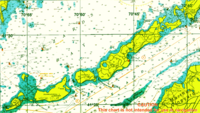Penikese
| The Elizabeth Islands |
|---|
 |
| Islands listed in order from east to west: |
| Major Islands: |
| Nonamesset Uncatena Naushon Pasque Nashawena Penikese Cuttyhunk |
| Minor Islands: |
| Bachelor Baret Bull Cedar Gosnold Gull Rock Veckatimest Weepecket Islands |
Penikese Island is a 75-acre (300,000 m2) island off the coast of Massachusetts, United States, in Buzzards Bay. It is one of the Elizabeth Islands, which make up the town of Gosnold, Massachusetts. Penikese is located near the west end of the Elizabeth island chain.
Penikese Island enters the historical record in 1602 AD when the English explorer Bartholomew Gosnold and some of his crew visited the island. Their visit frightened four visiting Wampanoag Indians into hiding, and the explorers stole their canoe.
Originally tree covered, at some later time the tree cover was lost, and the island was later used for pasturing sheep. To this day, it remains primarily grass covered. Owned by several successive owners, it eventually became owned by a businessman named John Anderson who used it for vacationing.
In early 1873, Louis Agassiz, the famous Swiss-American naturalist, persuaded Anderson to give him the island and $50,000 to endow a school for natural history where students would study nature instead of books. The school opened in July 1873, initially headed by Louis Agassiz. Following his death in December, his son Alexander Agassiz ran the school. The school was closed following a fire in 1875, but some of the former students opened in 1888 the Marine Biological Laboratory, in nearby Woods Hole.
In 1904, following local opposition to two previously selected sites on the mainland, the state of Massachusetts purchased the island for $25,000 to use as a leprosy hospital to isolate and treat all Massachusetts residents with the disease. When opened, it had five patients. After being open for 16 years, it was closed in 1921 and the thirteen patients were transferred to the federal leprosy hospital in Carville, Louisiana. At the closing of the hospital, the state burnt and then dynamited the buildings, and all that remains of it is a small cemetery.
...
Wikipedia
